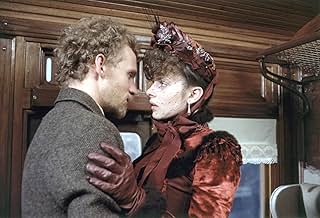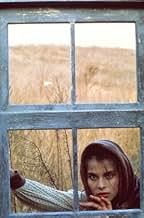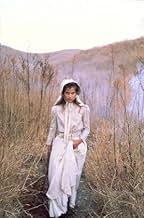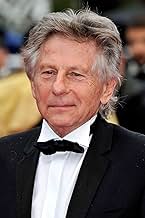AVALIAÇÃO DA IMDb
7,3/10
19 mil
SUA AVALIAÇÃO
Uma jovem camponesa com um caráter forte atrai o afeto de dois homens.Uma jovem camponesa com um caráter forte atrai o afeto de dois homens.Uma jovem camponesa com um caráter forte atrai o afeto de dois homens.
- Direção
- Roteiristas
- Artistas
- Ganhou 3 Oscars
- 16 vitórias e 17 indicações no total
Nastassja Kinski
- Tess
- (as Nastassia Kinski)
Avaliações em destaque
Roman Polanksi's Tess gets better and better with age.
The mists...the sounds of footsteps on the dirt roads... the ambling horse... the elflike man that appears at the Cross in Hands, Tess' walk to her Inlaws church, The dripping water, The taking of the boots, the misplaced letter, the milk run, the puddle in the road, the dripping milk pouches, The strawberry, the blood stain, The burial, Stonehenge...Everything is beautifully shot. It lingers in the mind long after viewing. Geoffrey Unsworth's final cinematographic film. Thank you for all your beautiful work.
It is neither pretentious nor bold.
Mesmerizing! The musical composition is charging.
Nastassja Kinski's plays the title character. She reacts so well. Her beauty in a time of such oppression and depression would be an ill fate. Tess knows this fate and she wishes she was never born. She is the sacrifice of a paradigm. Victorian era was finished. Edwardian Enlightenment would soon come but not for Tess, the sacrificial pure beauty.
Thomas Hardy created a pure woman in Tess. That is why her plight is so tragic. She possesses a strong spirit that is oppressed by the male political and religious world around her.
The opening shot is well directed in the morning sunrise as fair maidens dance with one another. Tess' oversight by Angel begins this tragic tale. "As Flies to wanton boys, are we to the Gods, they kill us for their sport."
Tess, Thomas Hardy
Do not take your eyes off of it. It is beautifully told!
Victor Nunnally, BFA Dramatic and Film Theory and History, AA Performing Experience.
The mists...the sounds of footsteps on the dirt roads... the ambling horse... the elflike man that appears at the Cross in Hands, Tess' walk to her Inlaws church, The dripping water, The taking of the boots, the misplaced letter, the milk run, the puddle in the road, the dripping milk pouches, The strawberry, the blood stain, The burial, Stonehenge...Everything is beautifully shot. It lingers in the mind long after viewing. Geoffrey Unsworth's final cinematographic film. Thank you for all your beautiful work.
It is neither pretentious nor bold.
Mesmerizing! The musical composition is charging.
Nastassja Kinski's plays the title character. She reacts so well. Her beauty in a time of such oppression and depression would be an ill fate. Tess knows this fate and she wishes she was never born. She is the sacrifice of a paradigm. Victorian era was finished. Edwardian Enlightenment would soon come but not for Tess, the sacrificial pure beauty.
Thomas Hardy created a pure woman in Tess. That is why her plight is so tragic. She possesses a strong spirit that is oppressed by the male political and religious world around her.
The opening shot is well directed in the morning sunrise as fair maidens dance with one another. Tess' oversight by Angel begins this tragic tale. "As Flies to wanton boys, are we to the Gods, they kill us for their sport."
Tess, Thomas Hardy
Do not take your eyes off of it. It is beautifully told!
Victor Nunnally, BFA Dramatic and Film Theory and History, AA Performing Experience.
This has been my favourite movie since I first saw it in the late 1980s, and I have viewed it probably once a year since that time. My videotape copy was fading and failing, so I was lucky to replace it recently with the Japanese DVD version.
When you compare it to other films made in 1979, it is amazing how little it has "aged". Of course, it is an historical drama, with a "timeless" setting. And yet the cinematography is so assuredly wonderful that the movie is almost as if set in amber.
Many have commented on the score, and it is a pity that this is no longer in issue. Still, there seem to be enough people like myself who are fans of this film, perhaps there is enough of an interest?
While the A and E version was an above-average production, I think Polanski's beats it on almost any characteristic. Polanski's film is a series of tableaux, very few of which do not work well. (One that I find a little bit stupid is the scene where Tess sleeps out in the forest and the deer comes to visit her. Gimme a break!). There are many scenes which, if left in still, look like 19th century portraiture, a la Mary Cassatt or Edgar Degas. The scene where the pedlar comes across Tess at the Crescent Hand! This guy has just stepped out of another century. This is a stunningly visual movie, and perhaps the reason it is so easy to watch time and time again. The dialogue, too, full of the cadences of West Country speech (still there, but disappearing) are an evocation of a lost age. These are hinted at in the scenes showing the modernization of England (the train bringing the milk to market, the threshing machine) which is changing their lives. Tess, and her aristocratic background, are an anachronism, particularly compared with the worldly (and successful) Stokes.
I enjoy the rhythm of the movie, which is rural and slow. Time is marked in slow and languid drips, such as we see with the milk at the dairy farm, and finally with the blood at the boarding house. This is classic story-telling, replete with foreshadowing (particularly Tess' temper and pride). What I enjoyed most is the symmetry of the story-telling, which make it more myth-like, particularly the juxtaposition of the two opening and closing scenes (the dancing of the village girls at sunset, and Stonehenge--which legend has as a circle of giants dancing and frozen by Merlin--at daybreak). Other examples are Alec Durberville's "saving" Tess from a fight with her "rival" and Angel choosing Tess over her rivals on the flooded road.
As you can see, Tess is a movie that replays itself in my mind. Polanski's effort reflects on what I think is one of the greatest 19th century English novels (in my mind, rivaled only by "Middlemarch"), and is a great springboard to further consideration of art and life.
When you compare it to other films made in 1979, it is amazing how little it has "aged". Of course, it is an historical drama, with a "timeless" setting. And yet the cinematography is so assuredly wonderful that the movie is almost as if set in amber.
Many have commented on the score, and it is a pity that this is no longer in issue. Still, there seem to be enough people like myself who are fans of this film, perhaps there is enough of an interest?
While the A and E version was an above-average production, I think Polanski's beats it on almost any characteristic. Polanski's film is a series of tableaux, very few of which do not work well. (One that I find a little bit stupid is the scene where Tess sleeps out in the forest and the deer comes to visit her. Gimme a break!). There are many scenes which, if left in still, look like 19th century portraiture, a la Mary Cassatt or Edgar Degas. The scene where the pedlar comes across Tess at the Crescent Hand! This guy has just stepped out of another century. This is a stunningly visual movie, and perhaps the reason it is so easy to watch time and time again. The dialogue, too, full of the cadences of West Country speech (still there, but disappearing) are an evocation of a lost age. These are hinted at in the scenes showing the modernization of England (the train bringing the milk to market, the threshing machine) which is changing their lives. Tess, and her aristocratic background, are an anachronism, particularly compared with the worldly (and successful) Stokes.
I enjoy the rhythm of the movie, which is rural and slow. Time is marked in slow and languid drips, such as we see with the milk at the dairy farm, and finally with the blood at the boarding house. This is classic story-telling, replete with foreshadowing (particularly Tess' temper and pride). What I enjoyed most is the symmetry of the story-telling, which make it more myth-like, particularly the juxtaposition of the two opening and closing scenes (the dancing of the village girls at sunset, and Stonehenge--which legend has as a circle of giants dancing and frozen by Merlin--at daybreak). Other examples are Alec Durberville's "saving" Tess from a fight with her "rival" and Angel choosing Tess over her rivals on the flooded road.
As you can see, Tess is a movie that replays itself in my mind. Polanski's effort reflects on what I think is one of the greatest 19th century English novels (in my mind, rivaled only by "Middlemarch"), and is a great springboard to further consideration of art and life.
In this adaptation of the Hardy novel, a peasant girl who may be descended from a noble family encounters romance and tragedy in 19th century England. Meticulously directed by Polanski, this epic drama unfolds quite leisurely but does not drag. The English countryside is beautifully captured, with the cinematography adding a haunting quality to the barren landscape, an effect further enhanced by the evocative score. Perhaps she does not faithfully embody the strong-willed heroine of the novel, but Kinski (resembling a young Ingrid Bergman) looks exquisite and effectively conveys a sense of melancholy in a star-making performance.
Roman Polanski's film Tess, (1979) adaptation of Thomas Hardy famous novel of the 19th century "Tess of the D'Urbervilles" , won many prestigious awards, including three Oscars of six nominations and every award for Best Cinematography it was nominated for. If any film deserves recognition for its beautiful, lyrical, sensual yet melancholic and poetic visual presentation, "Tess" is it. The movie might be Roman Polanski's finest achievement, and this statement comes from a viewer who is in love with all Polanski's films starting with his debut "Knife in the Water". "Tess" is one of the best adaptations of the classic novel I've seen and it lives, breathes and moves freely. It never rushes to tell its long story but tells it with rare finesse, compassion, and love for the heroine, a gentle creature who had been insulted, humiliated, and ultimately destroyed.
The success of the movie starts with the choice of the actress for the title role. Tess as played by 20 years old Nasstassia Kisnki is beautiful, sensual, shy and full of life and hope for love. The life of Tess unfolds in front of us from her teenage years as an innocent country girl until the powerfully tragic final scene at the magnificent Stonehenge. The film is almost three hours long but I never was bored, on the contrary, I felt compassion for the girl and anger toward the men that used and corrupted her, ruined her hopes for love and happiness, and toward the society that mercifully discarded of her. Tess is one of the best movies I've seen. It is stunning, subtle, emotional, tragic, and unforgettable.
The success of the movie starts with the choice of the actress for the title role. Tess as played by 20 years old Nasstassia Kisnki is beautiful, sensual, shy and full of life and hope for love. The life of Tess unfolds in front of us from her teenage years as an innocent country girl until the powerfully tragic final scene at the magnificent Stonehenge. The film is almost three hours long but I never was bored, on the contrary, I felt compassion for the girl and anger toward the men that used and corrupted her, ruined her hopes for love and happiness, and toward the society that mercifully discarded of her. Tess is one of the best movies I've seen. It is stunning, subtle, emotional, tragic, and unforgettable.
This film was an almost exact replication of Thomas Hardy's novel "Tess of the d'Urbervilles". It's so rare to watch a film after reading the novel and not be disappointed by it, but this film didn't disappoint in any way.
Details, such as the whiteness of the maids' dresses, the sound of milk squirting into a bucket, the sloshing mud of a wet English turnip field, and the glint of adoration in the eyes of the young lovers -- all came gloriously to life as if fresh off the pages of the book.
I highly recommend this film for anyone who enjoys a good old fashioned Victorian love story.
Details, such as the whiteness of the maids' dresses, the sound of milk squirting into a bucket, the sloshing mud of a wet English turnip field, and the glint of adoration in the eyes of the young lovers -- all came gloriously to life as if fresh off the pages of the book.
I highly recommend this film for anyone who enjoys a good old fashioned Victorian love story.
Você sabia?
- CuriosidadesThe film's opening dedication at the start of the film states: "For Sharon". Roman Polanski dedicated this movie to his late wife, Sharon Tate, who was killed in 1969 by the Manson Clan. Before Tate's death, she had read the film's source novel by Thomas Hardy and was convinced that her husband would one day make a great film based on the novel, with the hope that she would star in it. Movie was released to the theaters exactly 10 years after her untimely death.
- Erros de gravaçãoAt the beginning of the final sequence, set at Stonehenge, someone's head can be seen at bottom-left.
- Versões alternativasThe film was first released to German cinemas uncut with a running time of 184 minutes. As the audience reaction was far from overwhelming the distributor decided to re-cut and re-release the film in a more "accessible" 134 minutes version. But at least one of the original prints had survived and was shown here at the local art house years later.
- ConexõesFeatured in The 38th Annual Golden Globe Awards (1981)
Principais escolhas
Faça login para avaliar e ver a lista de recomendações personalizadas
- How long is Tess?Fornecido pela Alexa
Detalhes
Bilheteria
- Orçamento
- US$ 12.000.000 (estimativa)
- Faturamento bruto nos EUA e Canadá
- US$ 20.093.330
- Faturamento bruto mundial
- US$ 20.101.247
- Tempo de duração
- 3 h 6 min(186 min)
- Cor
- Proporção
- 2.35 : 1
Contribua para esta página
Sugerir uma alteração ou adicionar conteúdo ausente


































